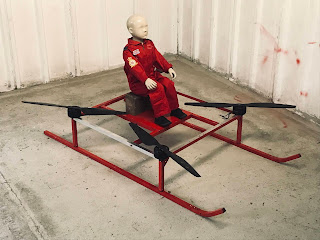Let's do it ~ build the world's lightest and most versatile people-carrying quadcopter.
I've started by envisioning the half-scale proof-of-concept that will haul Monty's ass around the sky. And having started to sketch it out on A4, I quickly abandoned doing so for Apple's Pages. This includes many features of what used to be called 'desktop publishing' back in the day and here its most useful feature is the ability to dimension the parts fairly quickly.
Pages accepts inches as an overwrite for centimetres and thus we can go for an A4 portrait format at the outset, and I have gone for a 1:10 scale diagram of the proof-of-concept (POC), which itself is base upon a 32" outline... and indeed 32" propellers.
Suppliers like T-motor work in metric until talking about propellers, when in deference to the US ~ who invented flying ~ they switch to inches instead. And for the POC I am using what I have in the workshop in the form of 32" propellers fitted to T-motor U13s.
And the nice thing about the design is that the perimeter lengths match the same diameter of 32" because the three-way connectors that join them together add a further inch to either side (so that the OUTSIDE dimension of the square is 34").
As the motors will be pitched centrally on the inch-wide connectors their axes are pitched 33" apart, allowing for blade clearance. So we'll order 4 x 32" x 1/16" lengths of alloy in order to define the 'square-frame' that supports the power-plants.
I guessed at the size of the centre-section and at 16" square it seems to fit the job. Accordingly, with the inside dimensions of the square-frame set at 32" there is eight inches of clearance all around the centre-section. Nonetheless we must subtract the one-inch width of each of the abutting cantilevers, which takes us down to 23".
Beyond that there are threaded inserts in either end of the cantilevers in order to fix the abutment and connect the flight-deck to the square-frame. From our mock-up we saw that a couple of connectors run to around 3/8th inch, so we have the following to order from our tube stockist:
(a) 4 off at 32" x 1/16" perimeter lengths (total 128")
(b) 4 off at 22⅝" x 1/16" cantilevers (circa 96")
This adds up to 224" or 5.67 metres in the UK, good if you can find stock lengths of six metres, but bad if like my supplier they only do five. Nonetheless I've enough left-overs to make a start.
However a quick look at retail sites in the US like:
... reveals that 288" is a stock length, so you've enough left over for four legs too!
How long are the legs going to be? Well I haven't decided yet and I shall deal with it at the same time as the landing skids, which can be tailored to operational circs. There's a precedent for this, as an image search on 'Hughes 500' shows longer and shorter legs over the course of history.
FAQ Dave from Oklahoma asks, "Should I be nervous seeing that the centre-section appears to be overlapped by the prop-disks?"
ANS When will this generation listen? The motors pitch the props higher, and their efflux funnels considerably, reducing any losses. The mannekin will be set above the line of the disks anyhow, as we saw recently in the scriptures:
"And Colin raised them in their hour of need, above the line of their rotor-disks."

































